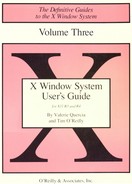Book Description
The X Window System User's Guide orients the new user to window system concepts and provides detailed tutorials for many client programs, including the xterm terminal emulator and window managers. Building on this basic knowledge, later chapters explain how to customize the X environment and provide sample configurations.
This popular manual is available in two editions, one for users of the MIT software, one for users of Motif. The Standard Edition uses the twm manager in most examples and illustrations. Revised and updated for X11 Release 5. Contents include:
Starting the system and opening windows.
Using the xterm terminal emulator and window managers.
Most standard release clients, including programs for graphics, printing, font manipulation, window/display information, removing windows, as well as several "desktop" utilities.
Customizing the window manager, keyboard, display, and certain basic features of any client program.
Using and customizing the mwm window manager, for those using the OSF/Motif graphical user interface.
System administration tasks, including managing fonts, starting X automatically, and using the display manager, xdm, to run X on a single or multiple display.
Table of Contents
- Coverpage
- Titlepage
- Copyright
- Table of Contents
- Figures
- Examples
- Tables
- Preface
- PART ONE: Using X
- 1 An Introduction to the X Window System
- 2 Getting Started
- 3 Using the twm Window Manager
- Starting the Window Manager
- Titlebars
- The Twm Menu
- Button Control of Window Manager Functions
- Customizing twm
- Some of My Keystrokes are Missing
- 4 The xterm Terminal Emulator
- 5 Font Specification
- 6 Graphics Utilities
- Creating Icons and Other Bitmaps
- Bitmap Editing Commands
- Pointer Commands
- Bitmap Command Boxes
- Acting on the Entire Grid: Clear All, Set All, Invert All
- Acting on an Area: Clear Area, Set Area, Invert Area
- Copy Area, Move Area, Overlay Area
- Drawing: Line, Circle, Filled Circle
- Filling in a Shape: Flood Fill
- Hot Spots: Set Hot Spot, Clear Hot Spot
- Saving and Quitting: Write Output, Quit
- Creating a Bitmap from a Cursor
- Magnifying Portions of the Screen: xmag
- Bitmap Editing Commands
- Creating Icons and Other Bitmaps
- 7 Other Clients
- PART TWO: Customizing X
- 8 Command Line Options
- 9 Setting Resources
- 10 Customizing the twm Window Manager
- 11 Setup Clients
- PART THREE: Client Reference Pages
- PART FOUR: Appendices
- A System Management
- Including X in Your Search Path
- Setting the Terminal Type
- A Startup Shell Script
- Starting X
- Starting X with the Display Manager, xdm (Release 4)
- Customizing xdm
- Stopping xdm and the Server
- X Terminals and the XDM Control Protocol (Release 4)
- Release 3 xdm
- Release 3 Special Files and the Config File
- Customizing the Release 3 xdm
- Starting X with xinit
- An Older Method of Starting X: /etc/ttys
- Server Access Control
- Font Management
- Console Messages
- Log Files
- Changing the Color Name Database
- B The uwm Window Manager
- C The OSF/Motif Window Manager
- Getting Started with mwm
- Starting mwm
- Selecting the Window to Receive Input
- Manipulating Windows with the mwm Window Frame
- Manipulating Icons
- The Root Menu
- Customizing mwm
- Setting mwm Resources
- D Standard Cursors
- E Release 3 and 4 Standard Fonts
- F xterm Control Sequences
- G Standard Bitmaps
- H Translation Table Syntax
- Glossary
- Index
- A System Management
